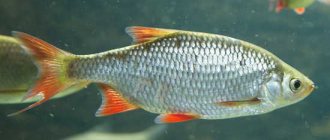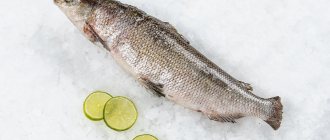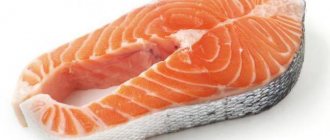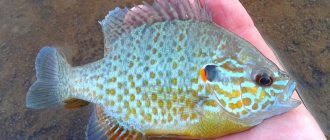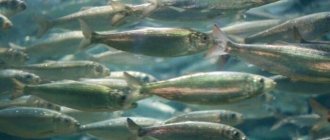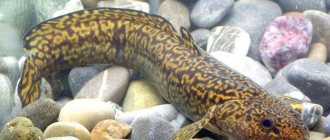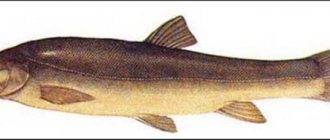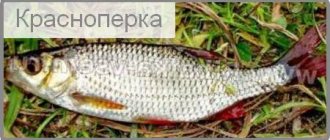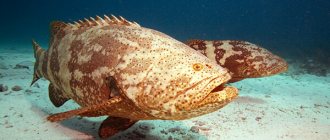Description
Rudd Rudd
(lat. Scardinius erythrophthalmus) is a small freshwater fish of the carp family.
Its body is quite tall, its back is brownish-green, its sides and body are a shiny yellowish-golden color, its eyes are orange, with a red spot at the top. The dorsal fin is blackish at the base, red at the apex, the pectorals are gray, red at the apex, all others are bright red; even raspberry ones. Large specimens of rudd are especially brightly colored during spawning. Rudd is sometimes confused with roach, or rather, brightly colored roach are mistaken for rudd. But these types are very different from each other. The rudd's mouth is directed upward, its teeth are double-rowed, saw-toothed. The dorsal fin is strongly pushed back, it begins behind the beginning of the ventral fins, and ends close to the anal fin; the belly behind the ventral fins is strongly compressed, forming a keel covered with scales.
Distribution and habitats
Rudd
relatively widespread in our water bodies.
It is especially numerous in the rivers of the Black, Azov, Caspian and Aral seas. It is also found in the Baltic states and Siberia. In the east of the country, along the Pacific coast, the Far Eastern rudd, or ugai, lives. In general, the rudd lives in many rivers and lakes in France, England, throughout Central Europe, and Sweden; in Russia its northern border is not known with certainty, but it is found in southern Finland (up to Biorneborg), although it does not reach Lake Onega. Judging by this, we must assume that it is not present at all in all the rivers flowing into the White and Arctic Seas, but this still requires confirmation, since it may very well happen that there, as in many other places, it is mixed with roach, and sometimes a bream. Distribution and habitats of rudd
Although rudd, like roach, avoids fast currents, the habitats of these fish are quite different. Rudd lives in river bays and oxbow lakes, flowing ponds, both small and large lakes and reservoirs. Unlike roach, it prefers more remote places where reeds, reeds, arrowheads, water lilies and other aquatic plants grow in abundance. Here, in addition to food, there is always shade and shelter from predators. Moreover, there is a certain pattern. Closer to the shore, among bushes and snags, in clogged “strong” places live small fish that usually live in schools. Large rudds, although they approach coastal reed beds to feed, still spend most of their time in the open, choosing underwater hills far from the shore, overgrown with grass.
The main habitat of the rudd is bays and oxbow lakes, as well as flowing ponds and lakes, where reeds, reeds and other aquatic plants grow in abundance. Here it is quite often found in a community with crucian carp, tench and bream and leads an almost sedentary life, rarely moving away from the place it has once chosen. Therefore, it is not found everywhere, but in some places, and where it is very numerous, where it is very rare. In any case, it is apparently much more common in southwestern and southern Russia than in the middle provinces. So, for example, in the lower reaches of the Volga it is found in abundance in all ilmens and quiet overgrown channels, and is also very common in all large and medium-sized lakes of western Russia. In the provinces near Moscow, it is found mainly in flowing ponds, although in very few, but in large quantities - in flood lakes and oxbow lakes.
Lure
In reservoirs where fish of other species, such as bream and carp, do not arrive at the fishing site too quickly, it is worthwhile to purposefully feed rudd. To do this, I use a bait mixture that scatters to the sides when it hits the water surface.
My feed mix consists of a bag of Amino Flash Dark Mix from FTM and half a bag of Crazy Krill Pellet & Paste Powder from Browning. Thanks to the dark FTM food, there is no light spot on the feeding area, which large individuals are afraid of. The proportion of crustaceans (“krill”) helps to attract rudd. I always add a few grains of corn to my bait. This feed mixture has proven itself for many years.
Since large rudds are very rare, a defeated opponent must be handled with extreme caution. It is best to keep this golden fish in large cages at least 3 m long or release it immediately after catching. And then the golden beauties will be able to please us more than once again.
Age, size, spawning
Body length can reach 36 cm, and the maximum known weight is 2 kg; The usual dimensions are 16-19 cm and weight 100-300 g. Life expectancy is up to 10 years.
Rudd grows quite slowly. Rudd is a slow-growing, low-value fish species. In the first year it reaches a length of 3 cm and a weight of 1 g, at 3-4 years 10-12.5 cm and a weight of 23-48 g, by 8 years - only 20 cm and a weight of about 200 g. In commercial and amateur catches, more often In total, there are individuals aged from 3 to 5 years with a mass of 23 to 120 g, larger specimens are rare. From analyzes of catches, it is known that the maximum weight of this fish achieved in Russian reservoirs is about 1 kg. The rudd can live up to 12 years.
The rudd matures in the 4th-5th year of life, with a length of more than 12 cm. It lays eggs in portions in quite large quantities - 96-232 thousand eggs. Spawning occurs at the end of May, in June, when the water temperature reaches 18-20°C. During spawning, the rudd does not jump to the surface, does not splash, as many other cyprinids do, but lays eggs silently. Only the quiet swaying of reed and reed stems indicates that spawning is taking place in these places. The eggs attach to plant stems. It is not possible to observe a mass spawning movement: it is carried out in small scattered groups, sometimes together with bleak, tench, and bream, and rudd can interbreed with bleak and bream, forming crosses. By the breeding season, she matures 2 portions of eggs, and the third - directly during the spawning period. The caviar is small, the diameter of the mature egg is about 1 mm, the color of different portions is clearly distinguishable: mature caviar is bright yellow, the next portion is pale yellow, the third is whitish. The fertility of females is very high: in a rudd 12-13 cm long, the absolute fertility is about 10.5 thousand eggs, in fish 16-17 cm long - about 23 thousand, in fish 22-23 cm long - 125 thousand eggs or more. Relative fecundity ranges from 220 to 400 eggs per 1 g of weight. Although the quantity of eggs laid is large, the number of rudd in reservoirs is insignificant. This is due to the fact that the bulk of the eggs die during incubation in unfavorable conditions: in shallow waters due to silting or drying, part of the eggs remains unfertilized, since females often lay eggs without males. A significant part of the generation dies after hatching during larval development. Incubation of eggs lasts 3-4 days, all stages of larval development are completed by mid-summer and fry are formed by August.
Individual characteristics
The rudd is a fairly beautiful fish, but not very proportional in appearance. Its sides are quite strongly flattened, making it resemble a bream rather than a roach.
The main distinguishing feature is the fins of a rich red hue. The only exception is the dorsal fin, which can be yellow or bright orange. This fish prefers to live in reservoirs with calm currents. It is noteworthy that the rudd, a fish that has its own ecological niche and always tries to hide among algae and reeds, spends most of its life in the middle or upper layers of reservoirs.
Due to its unpretentiousness in choosing food, this fish is one of the most common. It feeds mainly on plankton and various underwater plants.
The weight of adult individuals rarely reaches a kilogram, but in some cases individual fish can weigh several kilograms. First of all, this is due to the peculiarities of its development. It is noteworthy that at three years the fish weighs approximately 30 grams. At 5 years old - 60 grams, at seven years old - from 100 grams, and at 9 years old - up to 500 grams. Moreover, its lifespan is approximately a quarter of a century. Sexual maturity occurs in the third year of life.
Lifestyle
Lifestyle of the rudd According to the generally accepted opinion, the rudd is a rather sluggish and lazy fish, in its lifestyle it occupies a kind of middle ground between roach and crucian carp.
It constantly stays at medium depths in grass, even more reeds, especially at a young age, does not like strong currents and is not even found in fast rivers. Its food, as one would expect, consists mainly of plant matter, partly insects, larvae and worms. According to fishermen, in the spring the rudd feeds almost exclusively on silkworm, a filamentous algae that floats in the lulls and ilmens in the form of thin bright green threads; this makes the fish seem to take on a greener color, and its meat acquires a more bitter taste. Indeed, rudd meat is very bitter in summer, and many fishermen attribute this bitterness to its exclusively plant food. In the fall, the rudd usually goes to deep and quiet places and lies there throughout the winter. According to observations of the rudd, this is, relatively speaking, a rather strong, lively and cautious fish; in all these respects it is superior to the roach, its constant companion, although their locations are somewhat different. It is the rudd that is found in the greatest numbers in the densest thickets of grasses, mainly in reeds, reeds, between burdocks (water lilies) and near water moss, so that in overgrown ponds it is always more numerous than roach. Like tench, it is thus found in greatest numbers in the upper reaches of the pond and almost never goes out into open, unovergrown places; but she, however, does not like shade and fresh water and does not stick to the bottom, like tench and roach, and therefore swims all summer (from mid-May to mid-August), b. hours at half-water, and in sunny weather - in its upper layers, approximately 15 cm from the surface; In general, she loves to bask in the sun. In hot weather, it even swims completely on top and leads an even more diurnal lifestyle than pike and perch: it is visible only from sunrise to sunset (except during spawning); in the evening it goes into the lower, warmer layers of water and gets buried in the grass, mostly in the so-called. water moss or into reeds and reeds. The largest rudd stays in the reed and reed thickets all day and swims here at the very bottom, only coming out to their outskirts.
The rudd never goes under the floating shores - the favorite habitat of the tench in hot and cold weather, and also does not hide (in hot times) under bushes and roots on the shore, like the roach, which, at least when cohabiting with the rudd, sticks to more open places and swims mostly close to the bottom. Rudd loves to swim near swimming pools, bridges, rafts, but only if grass grows nearby. It positively does not move even a few meters away from the thickets and does not like even a weak current, although it willingly stays in quieter places in the mill pool, attracted here by the abundance of food. In the speed of its movements it is in no way inferior to the roach, and anyone who has seen with what force it splashes or, rather, tumbles, playing on the surface, will probably say that this splash is made by a stronger fish than the roach.
The food of the rudd consists, according to my observations, of young shoots of plants, filamentous algae (Spirogyra, Cladophora - mulberry, “greens”), worms, insects, eggs of other fish, as well as juveniles. In summer, rudds very willingly, apparently, eat snail eggs on the underside of water lily leaves; Often in the thickets of water lilies, ubiquitous smacking can be heard - these are rudds cleaning off the slimy eggs of snails stuck to the leaves. A similar sound is often made in the air by a caught rudd.
Bait selection
- Rudd can be called an omnivorous fish, so a wide variety of baits are used:
- Dough and semolina, with the addition of bright dye and a sweet ingredient.
- Bread, preferably rye, rolls the crumb into small balls, which are placed on a hook.
- Insect larvae: maggot, caster (pupated maggot), caddisfly, centipede mosquito larva (bloodworm), bark beetle larva and dragonfly;
- Insects, bait can be a fly, small grasshopper, mayfly, cricket, gadfly, various small beetles.
- Cereals, most often pearl barley, peas and corn are used, but you can try fishing with any grain.
- Worms, both earthworms, dung worms and white peat worms are suitable. It is necessary to give them the opportunity to free their intestines from the soil by placing them in bran or damp moss for a day.
- Artificial baits, you can use colored foam balls together with a floating feeder, silicone simulators of maggots, worms. When fishing with a spinning rod, small rotating spoons, wobblers and twisters made of soft silicone are used. Sometimes artificial flies, especially brightly colored ones, work well.
- Depending on the time of year, the rudd may change taste preferences:
- In winter, 3-4 mm jigs and baits of animal origin are used for fishing, mainly bloodworms, maggots, and burdock moth larvae. No less catchy, but difficult to obtain: amphipod larva, caddis fly, pieces of leech;
- In the spring, in cold and muddy water, mainly animal baits are used: bloodworms and dung worms, but you can try to fish with colored dough. This period is favorable for spinning bait using small artificial baits. After spawning, the bite on baits of plant origin becomes more active.
- In the summer, you can use any bait with equal success, and it all depends on the individual characteristics of the reservoir. Bait from winged insects brings excellent results: flies, grasshoppers, horseflies.
- In autumn, there is a gradual abandonment of plant foods. By mid-October, the main diet consists of larvae and worms. Good results are achieved by using small spinners.
- The choice of bait can be influenced by water transparency:
- In case of cloudy water, it is better to use brighter baits: red worm, bloodworm, tinted dough, pea mastyr.
- In clear water, the rudd spends most of its time close to the surface, and such light-colored baits as maggots, semolina, and bread are clearly visible to it.
- Some baits you can prepare yourself:
- The dough is kneaded according to numerous recipes, starting with two components (water and flour) and ending with a dozen ingredients. Quite good results are demonstrated by a stiff dough made in the following way: 1 part semolina and 4 parts wheat flour are mixed together. Add pink (or red) food coloring, a little honey and crushed roasted seeds. For greater stickiness, beat in an egg. The result is a fragrant, sweet, colored dough that holds well on the hook.
- Mastyrka is prepared from assorted semolina and pea flour. To prepare mastyrka, you need to boil several glasses of water in a saucepan. Add half a glass of pea flour and, stirring constantly, cook until a homogeneous mass is obtained. Semolina is added in an amount sufficient to remove excess water. The pan is removed from the heat. Add a few egg yolks, a spoonful of honey and a bag of vanilla sugar. Add semolina in small portions until the consistency of the mixture resembles dough. The mastyrka is thoroughly kneaded in order to achieve the elasticity of the plasticine.
- Special attention must be paid to storing live bait. If handled correctly, it can be used for several weeks or even months. The bait feels best in an air-permeable wooden container at positive temperatures close to zero, on the bottom shelf of the refrigerator. If there is a need to preserve bait of animal origin in the field, proceed as follows:
- Bloodworms - stored in a foam or wooden box on damp foam rubber; as the foam dries, it becomes wetted.
- Maggot - feels great in a glass container, sprinkled with bran and sand.
- Caddisfly - must be in a humid environment. To do this, it is kept in a jar half filled with wet moss. For caddisfly larvae, mayfly and its larvae, the jar is filled with water.
- Grasshopper, cricket, fly and other flying insects are kept in a ceramic or glass container with a narrow neck filled with fresh grass.
- Worms - stored in a foam or wooden box filled with bran, moss or native substrate.
There are several general rules to ensure the survivability of bait:
- the container intended for storing bait must allow air to pass through in sufficient quantities;
- To ensure a cooler storage microclimate, containers with bait should be wrapped in a damp canvas rag or bag.
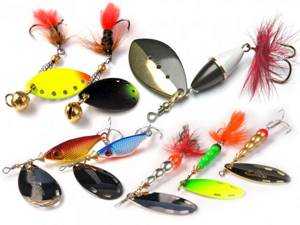
Catching rudd
Catching rudd The most universal tackle for catching rudd
is considered to be a float rod. At the present stage, this is a telescopic carbon fiber rod 5-6 meters long without guide rings and a wire reel, equipped with an inconspicuous elastic fishing line of 0.2 mm, a leash of 0.1-0.15 mm, a pellet sinker, and a sharpened hook No. 3.5- 4 and a small float. Thicker lines are practically unsuitable for a float rod.
Some authors recommend catching rudd without a float, replacing the hook and sinker with a regular jig. They explain this by the fact that fishing with a jig is more productive than when fishing with a float rod.
There should be no loops, swivels or carabiners on the fishing line - all this is unnecessary. The fishing line must be “tightly” attached to the rod. It should be borne in mind that the reliability of the entire tackle largely depends not only on the diameter and quality of the fishing line, but also on the way the fisherman ties the hook. Before tightening the knot, it is recommended to moisten it with hot water.
Only in this case will your tackle be light, elegant and easy to use. Aesthetics will not be superfluous here.
As replacement equipment for your float rod, always carry with you a set of inserts made of fishing line of various diameters and colors, wound on a reel. Sinkers and floats must be carefully balanced, and hooks must have different shank lengths. If, for example, you put a grasshopper on a hook with a short shank, then the rudd easily knocks it down, while remaining unpunished. For maggots and bloodworms, on the contrary, hooks with a short shank are better.
The rudd leads a diurnal lifestyle. In the evening it goes to the lower layers of water and hides in the grass. In winter it lies in hibernation pits and is not caught with a fishing rod. In the spring, fishing for rudd can begin after the flood waters have subsided.
In May - June, rudd spawns. At this time, in all regions of the country there are bans on fishing of any kind. In the central part of Russia, it is not even allowed to launch boats during the spawning period. True, sport fishing from the shore with one fishing rod and one hook is permitted.
Ichthyologists believe that during the day in summer the rudd has two maximum feeding intensity: morning - from 7 to 9 o'clock and evening from 17 to 19, i.e. The most productive fishing time is the morning and early evening hours.
The choice of bait and bait with which the angler intends to seduce the rudd is one of the most important conditions for success. Usually, semolina is used as bait, and dung worms, maggots and bloodworms are used as bait. The entire range can be significantly expanded.
At the beginning of fishing, they try everything that they brought with them this time, until it becomes clear what kind of attachment or bait the rudd prefers today. In spring they are usually caught using bloodworms and red dung worms. They are the ones that are best seen in muddy water. During the winter, the fish have become hungry and willingly bite on them.
It should also be borne in mind that rudd prefers small and medium maggots. This is explained by the fact that they wriggle on the hook more actively than large maggots and, naturally, attract more attention to themselves.
At the height of summer, rudd can be caught well with a housefly, a small grasshopper and a crayfish. Fishing large rudd on dragonfly larvae can be successful.
Rudds are usually caught by casting baited hooks along reeds or reeds, into gaps between vegetation, or “windows.” The bait is placed approximately 30-40 cm from the float. Each time after casting, if there is no bite immediately, it is advisable to pull the float a little towards you so that the line between it and the rod is taut - this will make your tackle more sensitive and the bite more noticeable. Quite often the bite occurs when the bait is immersed. Sometimes the rudd grabs the bait as soon as it reaches the surface of the water.
In the summer, when there are a lot of insects and their larvae, you can catch them with slowly sinking bait. The length of the descent depends on the fishing depth, because... Every time after the bait sinks to the bottom, you need to make a new cast. A sinker is not required for this fishing method. A bite when fishing without a sinker looks quite peculiar: the float will suddenly float to the side, then come back, float again and eventually suddenly and completely go under water. You need to cut at the moment of greatest pull. Once the float disappears into the water, it’s too late to hook.
If after catching two or three rudds the bites stop, then do not rush to change the place. Sometimes a few minutes are enough for the fish to calm down and come again. It is much worse if the fish breaks loose. A broken rudd immediately makes such a “noise” that all its fellows will instantly scatter in different directions and huddle in the very thick of aquatic vegetation.
Where is the best place to catch rudd?
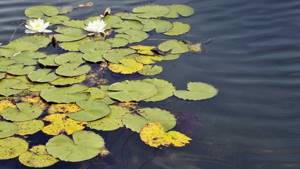
Rudd is not a fan of rivers with fast currents and steep rapids. Her favorite places of promise are well-warmed quiet pools, flowing reservoirs, and rivers with a slow flow. The main thing is that there is more vegetation there, among which you should look for this fish.
Usually the fishing depth does not exceed one to one and a half meters, but large rudd still prefer to stick to a two-meter depth. Rudd is a sedentary fish. She is reluctant to change her place of residence and feeds mainly in the same place.
